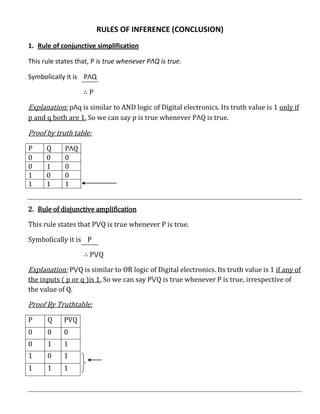
Rules of inference
- 1. RULES OF INFERENCE (CONCLUSION) 1. Rule of conjunctive simplification This rule states that, P is true whenever PΛQ is true. Symbolically it is PΛQ ∴P Explanation: pΛq is similar to AND logic of Digital electronics. Its truth value is 1 only if p and q both are 1. So we can say p is true whenever PΛQ is true. Proof by truth table: P Q PΛQ 0 0 0 0 1 0 1 0 0 1 1 1 2. Rule of disjunctive amplification This rule states that P⋁Q is true whenever P is true. Symbolically it is P ∴ P⋁Q Explanation: P⋁Q is similar to OR logic of Digital electronics. Its truth value is 1 if any of the inputs ( p or q )is 1. So we can say P⋁Q is true whenever P is true, irrespective of the value of Q. Proof By Truthtable: P Q PVQ 0 0 0 0 1 1 1 0 1 1 1 1
- 2. 3. Rule of Hypothetical syllogism: This rule states that P⟶R is true whenever P⟶ Q is true and Q⟶R is true. Symbolically it is P⟶Q Q⟶R ∴ P⟶R Explanation: P⟶Q is true, it states that P is not 1 and Q is not 0 concurrently. Same way, Q⟶R is true, it states that Q is not 1 and R is not 0 at the same time. (Because A⟶B is a conditional statement whose value is 0 only in one case which is when A is1 and B is 0)So we can say both these statements can take any other combination other than 1 and 0. Let’s say P is 1 ie Q is also 1. Going to statement (b), if Q is 1 from above statement, R must be 1. And if P is 1 and Q is 1 and R is also 1. This implies P⟶R is also one that is only our conclusion. Proof By Truthtable P Q R P⟶Q Q⟶R P⟶R 0 0 0 1 1 1 0 0 1 1 1 1 0 1 0 1 0 0 0 1 1 1 1 1 1 0 0 0 1 1 1 0 1 0 1 1 1 1 0 1 0 0 1 1 1 1 1 1
- 3. 4. Rule of Disjunctive syllogism This rule states that Q is true whenever P⋁Q is true and P is true. Symbolically it is P⋁Q (a) P (b) ∴Q Explanation: P⋁Q behaves the same way as OR gate in digital electronics ie, if any of the two inputs is 1 the output is 1. So if we know that PVQ is 1(from (a)) and P is 1 that means P is 0. So to support (a), Q has to be one only then the output of PVQ will be 1. This implies Q is 1 and that is our conclusion. Proof By Truthtable P Q P⋁Q P 0 0 0 1 0 1 1 1 1 0 1 0 1 1 1 0 5. Rule of Modus Pones( Rule of detachment) This rule states that Q is true whenever P is true and P⟶Q is true. Symbolically it is P (a) P⟶Q (b) ∴Q Explanation: P⟶Q is a conditional statement in discrete mathematics, which is false only in one case that is when p is true and q is false (or P is 1 and Q is 0 then p⟶q is 0 and in all other cases it is true.) Here we know that p is true, from (a) And P⟶Q is true (from (b)) ie Q must be true that is the conclution.
- 4. Proof By Truthtable P Q P⟶Q 0 0 1 0 1 1 1 0 0 1 1 1 6. Rule of Modus Tollens This rule states that ~P is true whenever P⟶Q is true and ~Q is true. Symbolically it is P⟶Q ……………… (a) ~Q ……………….. (b) ∴~P Explanation: P⟶Q is a conditional statement in discrete mathematics, which is false only in one case that is when p is true and q is false (or P is 1 and Q is 0 then p⟶q is is 0 and in all other cases it is true) We know that ~Q is 1from (b) ie Q is 0 ( we know that ~Q is inverse of Q) The above condition P⟶Q can be true only if P is 0 because if P is 1 and Q is 0 the output will be 0. So it signifies that p is 0 and ~P is 1 that is our conclusion. Proof By Truthtable P Q ~Q ~P P⟶Q 0 0 1 1 1 0 1 0 1 1 1 0 1 0 0 1 1 0 0 1